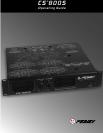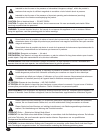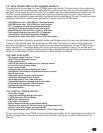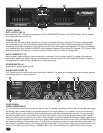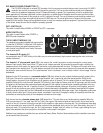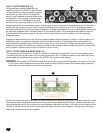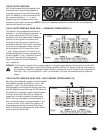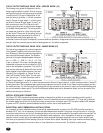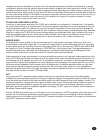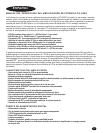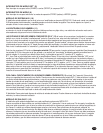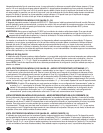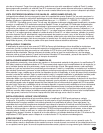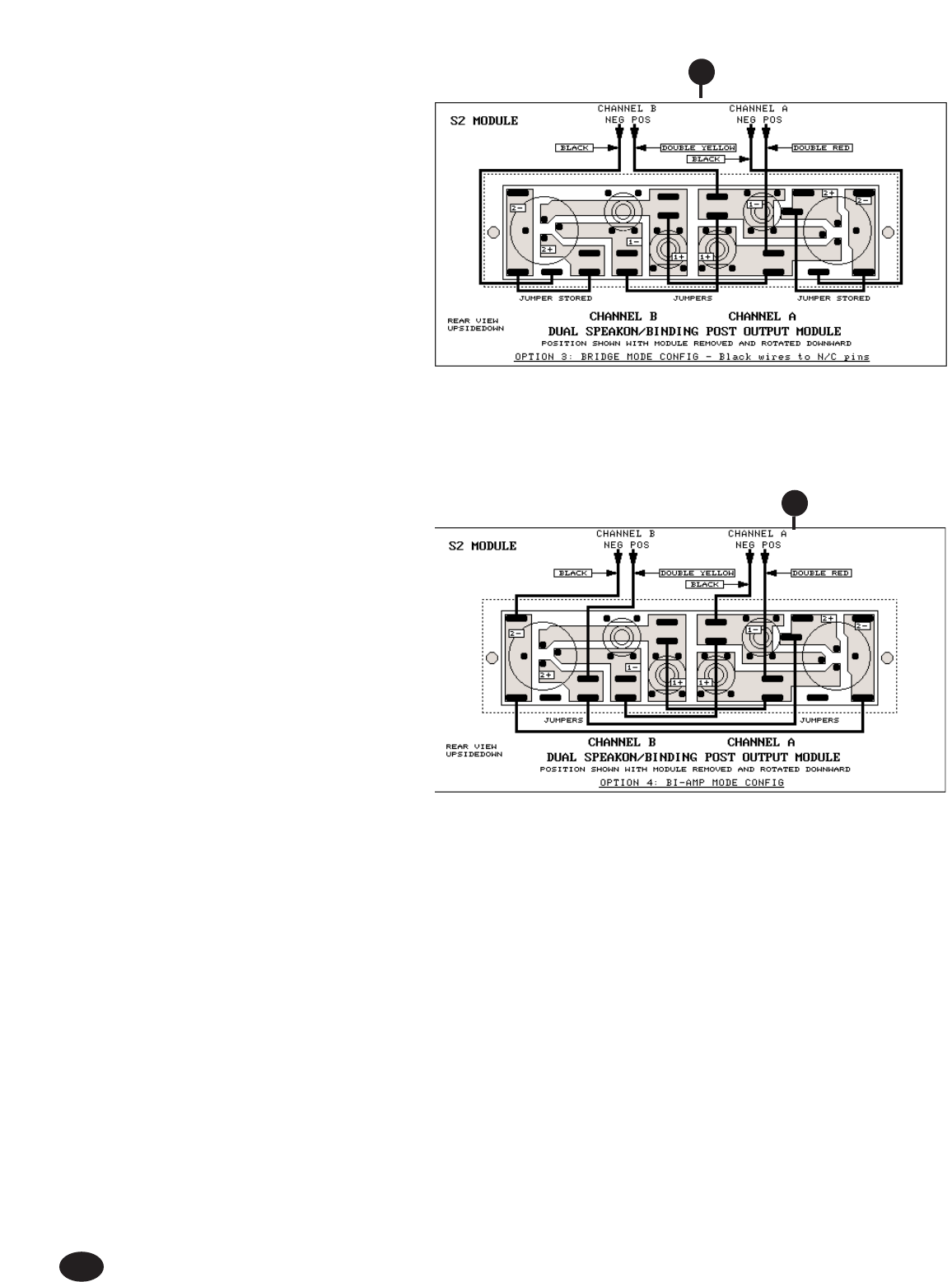
THE S2 OUTPUT MODULE REAR VIEW - BRIDGE MODE (19)
The following wiring allows the Speakons to be the
bridge outputs with both in parallel. Such an arrange-
ment permits two 8 ohm enclosures to be connected
in parallel to the CS-S amp in Bridge Mode. In this
case, the wiring is as follows: 1+ on both connectors
wired to Channel A signal output; 1- on both connec-
tors wired to Channel B signal output; 2+ and 2- on
both connectors not used. The Channel A and B
chassis ground wires are not used (and are plugged
into isolated floating terminals.) This wiring requires
one jumper per channel for a total of two; the other
two are “stored.” Please note for this wiring, both red
binding posts are now connected to the channel A
output, and both black binding posts are now
connected to channel B output. Consequently, to connect additional speakers in bridge mode one must use a red and black binding
post pair rather than connecting across both red binding posts as in the default arrangement.
THE S2 OUTPUT MODULE REAR VIEW - BIAMP MODE (20)
The final wiring arrangement is a natural progression
of the Speakon
®
capability with its four wire connec-
tions. Biamping is often the preferred configuration for
many sound reinforcement systems. The Speakon
pins used in the typical biamped speaker enclosure
are: 1+ = LOW+; 1- = LOW-; 2+ = HI+; 2- = HI-. This
is also a “standard.” In this case, two biamped wired
loudspeaker enclosures can be connected to a CS-S
amp via the two Speakon connectors. First, the CS-S
amp must be configured for biamp with each channel
signal supplied from a suitable crossover, and most
importantly, the configuration is: Channel A as the
“lows” and Channel B as the “highs.” For this mode
then, the wiring is: 1+ on both connectors wired to
Channel A signal output; 1- on both connectors wired
to Channel A chassis ground wire; 2+ on both connectors wired to Channel B signal output; 2- on both connectors wired to Channel B
chassis ground wire. This arrangement again requires two jumpers per channel for a total of four. Always check the diagram and wire
the module with care. For this wiring, both red binding posts are now connected to the channel A output, and both black binding posts
are now connected to chassis ground. Thus, both binding post red/black pairs are the biamped low output, and can be used to drive
additional sub enclosures, if desired.
INSTALLATION AND CONNECTION
The Peavey CS
®
800S commercial series power amplifier is designed for durability in commercial installations and the quality of
performance required in studio and home applications. The unit is a standard rack-mount configuration, 3 1/2" high and is cooled by
two variable-speed internal fans. All the input and output connections are on the back panel. The front panel contains LED indicators
for power and DDT activation, detented/calibrated sensitivity controls, and a mains power switch.
INDUSTRIAL AND COMMERCIAL INSTALLATIONS
For commercial and other installations where sustained high powered operation is required, the CS
®
800S should be mounted in a
standard EIA 19" rack. It is not necessary to leave rack space between each amplifier in the stack, since the fan pulls air in from the
rear and exhausts the hot air out the front. An adequate source of cool air must be provided for the amplifier when rack-mounted. The
internal fans must have a source of air that is not preheated by other equipment. If cool, the amplifier will start up in low-speed fan
operation, and will normally stay at low-speed operation unless sustained high power operating levels occur. As the amplifier heat
sinks heat up the automatic thermal sensing circuitry will increase the fan speed. Depending upon signal conditions and amp loading,
the fan speed may increase to a maximum value, or it may decrease to a minimum value. This situation is quite normal.
8
19
20



